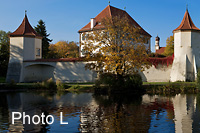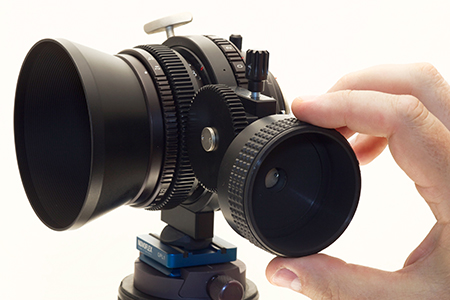 |
What's New
|
Customers
|
Dealers
|
Press
|
About Us
|
Blog
|
Français
|
Deutsch |
 |
|
A Revolution Benefits Comparison Data Sheet/Specification
Hartblei Lenses
Accessories
Buying Hartblei |
Technical Information (Part 1)
Why Shift and Tilt Superrotators?
During the last 10 years unique and exclusive to Hartblei (we welcome Canons recent anouncement to agree on the usefulness of this feature) is that our Shift and Tilt lenses are so-called "superrotators".
All Shift and Tilt functions are independently usable with full 360 degrees rotation each.
The result is a functionality and quality (up to 200 lp/mm resolution) that comes very close to that of a viewcamera, however with the mobility of a 35 mm camera.
Traditional lenses allow only to control the depth-of-field (DOF) by using focus and aperture. The perspective is fixed.
If the photographer wants to correct tilted lines in the image, created by tilting the camera, it can not be done.
An electronical correction of tilted lines using software is resulting in a bad quality (pixels that are not present in the
original shot can not be added by some piece of software without a loss in quality). The time for computing and editing the
corrected image slows down the production process. The necessary cropping of the image also removes pixels, resulting in a
smaller photo. In general, we recommend for a perfect workflow to do any steps analogue that can be done analogue (during the
shooting), and do any required corrections digitally during post-production. We have arranged a partnership with
Nurizon to achieve this.
Shift and Tilt lenses offer a parallel shift of the lens. This allows to capture a scene without tilting lines. The image circle
of Hartblei lenses is typically more than 80 mm. Using the "Shift" function you can remove tilted lines without tilting the camera.
It's done "in the lens" before the frame is actually captured.
Also, the Shift function allows you to create so-called "Stitches", i.e. images that have been stitched together from multiple
photos. With 10 mm Shift and a full format sensor (e.g. Canon 1ds mark II) you can reach an enlargement of the file by 183%.
A 16.7 MPixel camera suddenly becomes a 30.5 MPixel camera! The usable sensor size (net) increases to 44x36. With a crop factor of 1.3
the 40 mm lens behaves like a 30 mm lens, the 80 mm lens like a 61 mm, and the 120 mm like a 92 mm lens. That's why we think the
discussion about the focal lengths of Superrotators is utterly pointless.

 
In addition you will find that the optical quality of Hartblei Zeiss lenses is uniform throughout the photo, even at the far-out pixels at the side of a frame, thus making full use of your cameras' sensor size. You get higher quality when stitching images together, and you get extreme results from crop sensors. For example, a 16x24 mm crop sensor and three frames stitched together gets you a net increase of roughly 250% (a Nikon D2x results in a 30 Mpixel photo). The so-called "Tilt", i.e. the tilting of the lens, uses the Scheimpflugeffect (wikipedia). A very practical and illustrated (with java applets) tutorial youĞll find on the cambridgeincolour.com pages of Sean McHugh Page1 and Page2. For the best theory explanation indepth go this page: Harold Merklinger articles for Download. Scheimpflug discovered that any image will be sharp and focused as long as the three planes of object, film/sensor, and lens main axis are meeting in one point. Now, if you artificially change the focus point by using up to 8 degrees of "Tilt" offered by the lens, you can have very special effects with awesome "Bokehs" or interesting "Toybox" effects. Also you should note that a non-existing sharpness can not be re-gained by using software, not even partially. Which is why Tilt lenses are essential.
Part 2: Hartblei Superrotators are true digital lenses!
|
by Stefan Steib "One touch, and you have almost twice the file size, 30 MPixel at the cost of 16Mpixel." |
|
Copyright © 2007-2011 by Stefan Steib, Munich/Germany | Imprint |



